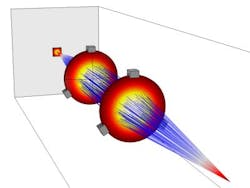Computer Modeling: COMSOL Multiphysics software adds ray-tracing capabilities
The COMSOL Multiphysics software package, a well-known suite produced by COMSOL, Inc. (Burlington, MA) that can numerically model many different types of physical processes, now has a new addition with special relevance to scientists and engineers working in photonics: a Ray Optics Module. As a result, those who have used the suite’s RF and Wave Optics Modules for high-frequency (radio and optical-range) electromagnetics modeling can now create models that take advantage of the relative simplicity and alternative approach of ray-tracing.
Such processes can be modeled separately or in combination with any other physics using the software package’s other modules, allowing the simultaneous and interrelated modeling of many different types of physical processes, including thermal, mechanical, electromagnetic, electrical, chemical, fluid flow, and others.
Both the RF Module and the Wave Optics Module include what is called the Electromagnetic Waves, Frequency Domain interface, which computes the full-wave solution to the electromagnetic wave equation. “Although a full-wave solution gives very accurate results for a length scale of a few wavelengths, the need to resolve every oscillation with a finite element mesh makes it computationally expensive to use in large geometries at high frequency,” explains Christopher Boucher, a software developer for COMSOL.
“The Ray Optics Module, which includes the Geometrical Optics interface, facilitates the modeling of electromagnetic wave propagation over distances that are so optically large that it is impractical to resolve individual waves using a finite-element mesh,” Boucher says. “When compared to the Electromagnetic Waves, Beam Envelopes interface, the Geometrical Optics interface involves more approximations but does not require the direction of wave propagation to be known in advance. This makes the Geometrical Optics interface useful for modeling large structures in which waves can propagate in many directions while undergoing reflection and refraction at boundaries.”
Modeling thermally induced focal shift
The addition of the Ray Optics Module enables physics-based modeling of, for example, thermally induced focal shift in a lens (see figure). “Here, rays propagating through a lens lose some of their intensity due to absorption by the glass, causing the lens to heat up,” says Boucher. “As the temperature of the lens changes, the refractive index changes, and the lens undergoes structural deformation. Since both of these effects can perturb the ray trajectories, it is necessary to trace the rays again in the thermally deformed lens system in order to obtain an accurate solution. With the Ray Optics Module, it is possible to create a solver loop that alternates between computation of the ray trajectories and the resulting temperature field until a self-consistent solution is obtained.”
The Ray Optics Module can also be used to compute ray intensity and analyze ray polarization by assigning variables for the Stokes parameters and principal wavefront radii of curvature of each ray, notes Boucher. The features that define the initial position and direction of rays can also be used to specify that the released rays have linear, circular, or elliptical polarization, and can specify a degree of polarization between 0 and 1. For ray-intensity computation, there are built-in options for releasing plane and spherical waves, as well as the more general option to specify the two principal radii of curvature of the wavefront.
“When rays interact with boundaries, the ray directions are computed using Snell’s Law. The intensity of reflected and refracted rays can be computed using the Fresnel equations, and the principal radii of curvature are reinitialized based on the curvature of the surface,” says Boucher. “Other notable features include options to release rays with a distribution of different frequencies, thin-dielectric-film boundary conditions, built-in boundary conditions for idealized optical components like wave retarders and linear polarizers, the ability to model ray propagation in absorbing or gain media, and built-in variables for optical path length and phase.”
No exporting needed
“One of the most common complaints that we have heard about industrial-grade ray-optics applications is the lack of a self-contained solution that considers all of the physics in the model,” notes Boucher. “Typically, a user must first trace rays in one software package, export the data to a file, import the data into another software package for thermal analysis, and so on. With COMSOL Multiphysics, it is possible to trace rays, consider structural and thermal effects, and analyze results within a single software package, greatly simplifying the workflow.”
Other potential applications include solar-energy harvesting; an illuminated surface (in this case, reflecting solar radiation) can be precisely defined and the direction of incident rays specified either directly or by selecting a date, time, and location. Small perturbations such as surface roughness and solar-limb darkening can also be considered.
Because it is easy to trace rays that have a distribution of different frequencies, it is also possible to model devices such as monochromators and spectrometers, says Boucher. For example, the library of models of optical systems that is part of the Ray Optics Module includes an example of a Czerny-Turner monochromator that uses a built-in grating-boundary condition to separate polychromatic light.
About the Author
John Wallace
Senior Technical Editor (1998-2022)
John Wallace was with Laser Focus World for nearly 25 years, retiring in late June 2022. He obtained a bachelor's degree in mechanical engineering and physics at Rutgers University and a master's in optical engineering at the University of Rochester. Before becoming an editor, John worked as an engineer at RCA, Exxon, Eastman Kodak, and GCA Corporation.

